YouTube to Blog Agent
Convert YouTube videos into Markdown blog posts with VoltAgent and MCP.
This VoltAgent example to show how a supervisor coordinates subagents that depend on MCP tools, shared working memory, and VoltOps LLM observability. The supervisor asks one subagent for the YouTube transcript, sends that text to a writer subagent, and returns a Markdown blog post.
Here is what the Agent does:
- Loads YouTube tooling over MCP with Server-Sent Events
- Delegates transcript retrieval and writing to two focused agents
- Stores transcript context in LibSQL-backed working memory
- Records execution traces through the VoltOps observability adapter
- Serves every agent through VoltAgent’s Hono server integration
Setup
- VoltOps LLM Observability account at console.voltagent.dev
- OpenAI API key from platform.openai.com
- Access to a YouTube MCP server. Community servers may throttle requests, so keep an alternate provider ready.
Get the example code
I use the VoltAgent CLI to scaffold the project:
npm create voltagent-app@latest -- --example with-youtube-to-blog
cd with-youtube-to-blog
You can browse the full source on GitHub in the examples/with-youtube-to-blog directory.
Configure environment variables
Create or copy a .env file with the required credentials:
# OpenAI Configuration
OPENAI_API_KEY=your_openai_api_key
# MCP Provider Configuration
YOUTUBE_MCP_URL=https://your-youtube-mcp-host/sse
# VoltOps Observability (optional)
VOLTAGENT_PUBLIC_KEY=your_public_key
VOLTAGENT_SECRET_KEY=your_secret_key
If you self-host VoltOps or LibSQL, add connection variables such as LIBSQL_DATABASE_URL and LIBSQL_AUTH_TOKEN. Without extra configuration the LibSQL adapters create local SQLite files inside the project directory.
Start the development server
Install dependencies and run the dev server:
pnpm dev
When the server starts, the terminal prints:
════════════════════════════════════════════
VOLTAGENT SERVER STARTED SUCCESSFULLY
════════════════════════════════════════════
✓ HTTP Server: http://localhost:3141
VoltOps Platform: https://console.voltagent.dev
════════════════════════════════════════════
[VoltAgent] All packages are up to date
I run the YouTube MCP provider separately so the TranscriptFetcher subagent can call the transcript tool.
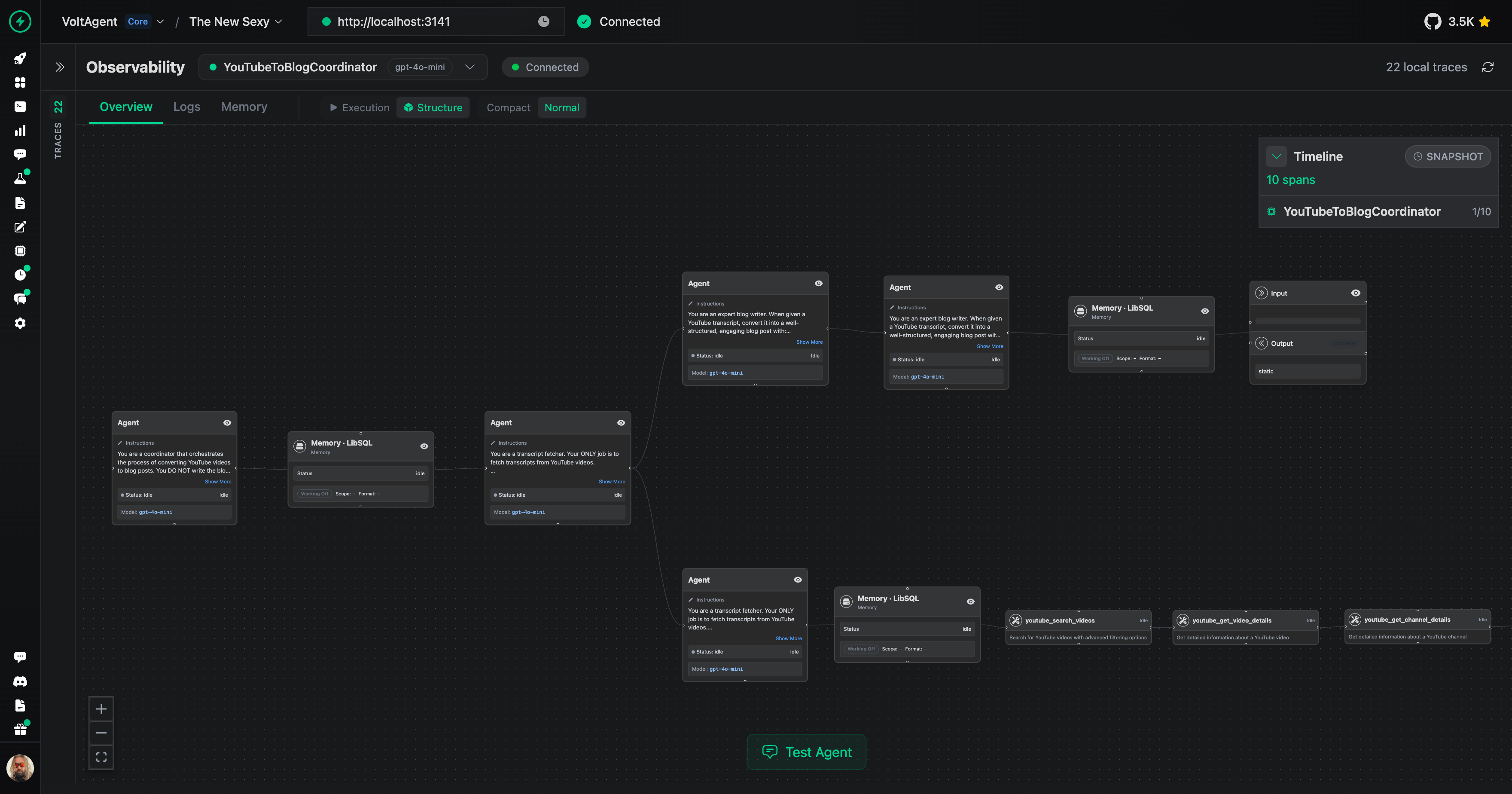
MCP Tool Registration
The coordinator discovers YouTube tooling through MCPConfiguration before the agents start:
const youtubeMcpConfig = new MCPConfiguration({
servers: {
youtube: {
type: "http",
url: process.env.YOUTUBE_MCP_URL || "",
},
},
});
const youtubeTools = await youtubeMcpConfig.getTools();
The YOUTUBE_MCP_URL must be reachable from the VoltAgent process and expose the SSE interface described in the MCP tooling guide.
MCPConfigurationpulls tool metadata from the HTTP SSE endpoint and converts it into the format VoltAgent expects.- I pass the resulting
youtubeToolsarray into the agents so they can call the transcript tool without extra wiring.
Agent Architecture
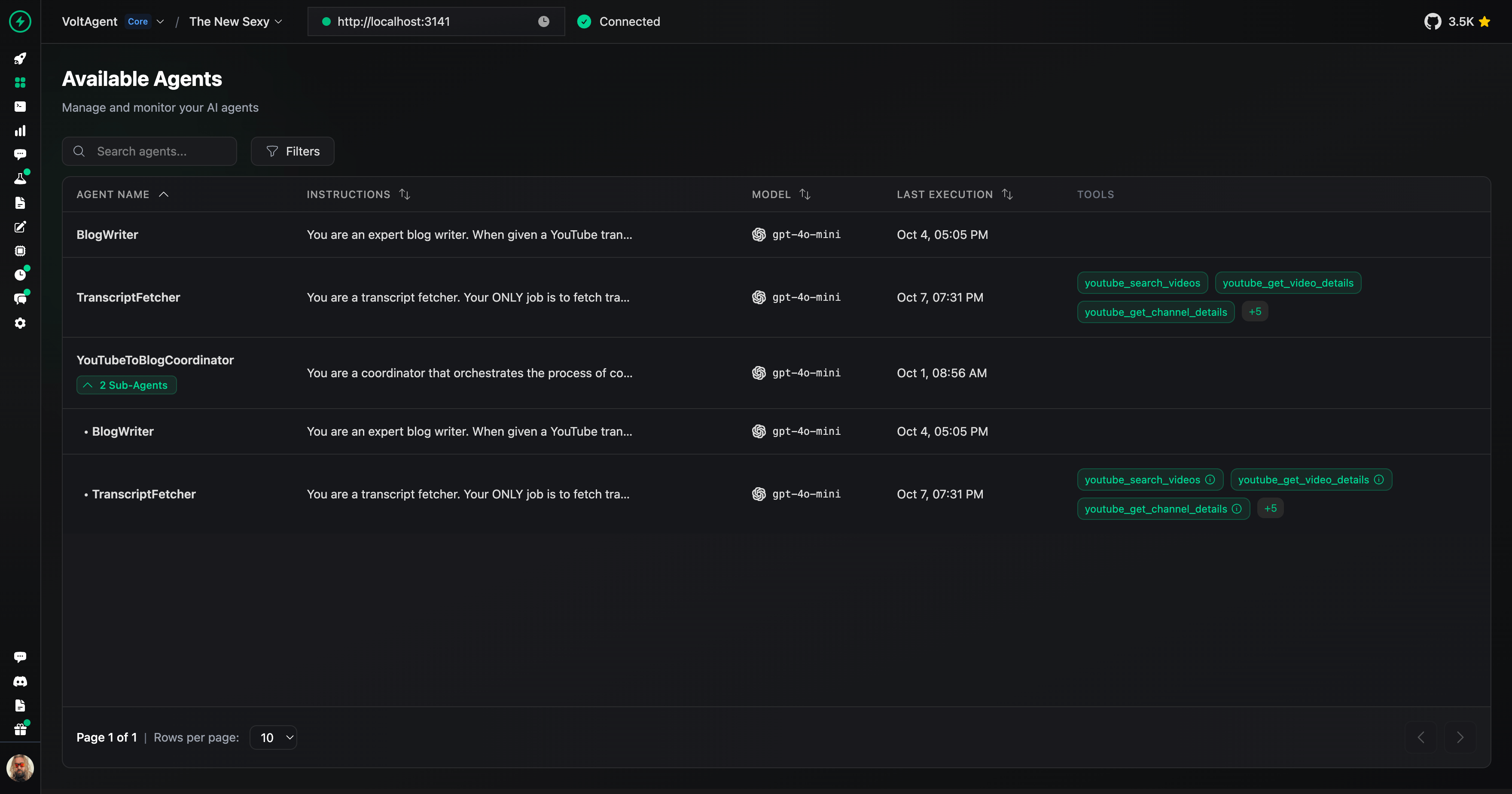
When someone asks for a blog post, the YouTubeToBlogCoordinator receives the prompt with the YouTube link. I wired the coordinator to follow a strict handoff:
- The coordinator calls the
TranscriptFetchersubagent, which relies on the MCP transcript tool to pull the full caption text. - After the transcript lands in shared memory, the coordinator calls the
BlogWritersubagent and passes the entire transcript as input. - The writer returns Markdown, and the coordinator responds with that Markdown as-is so downstream systems can store or publish it directly.
To support this flow I register three agents inside one VoltAgent instance. The supervisor coordinates both subagents and they all share the same memory and logging resources.
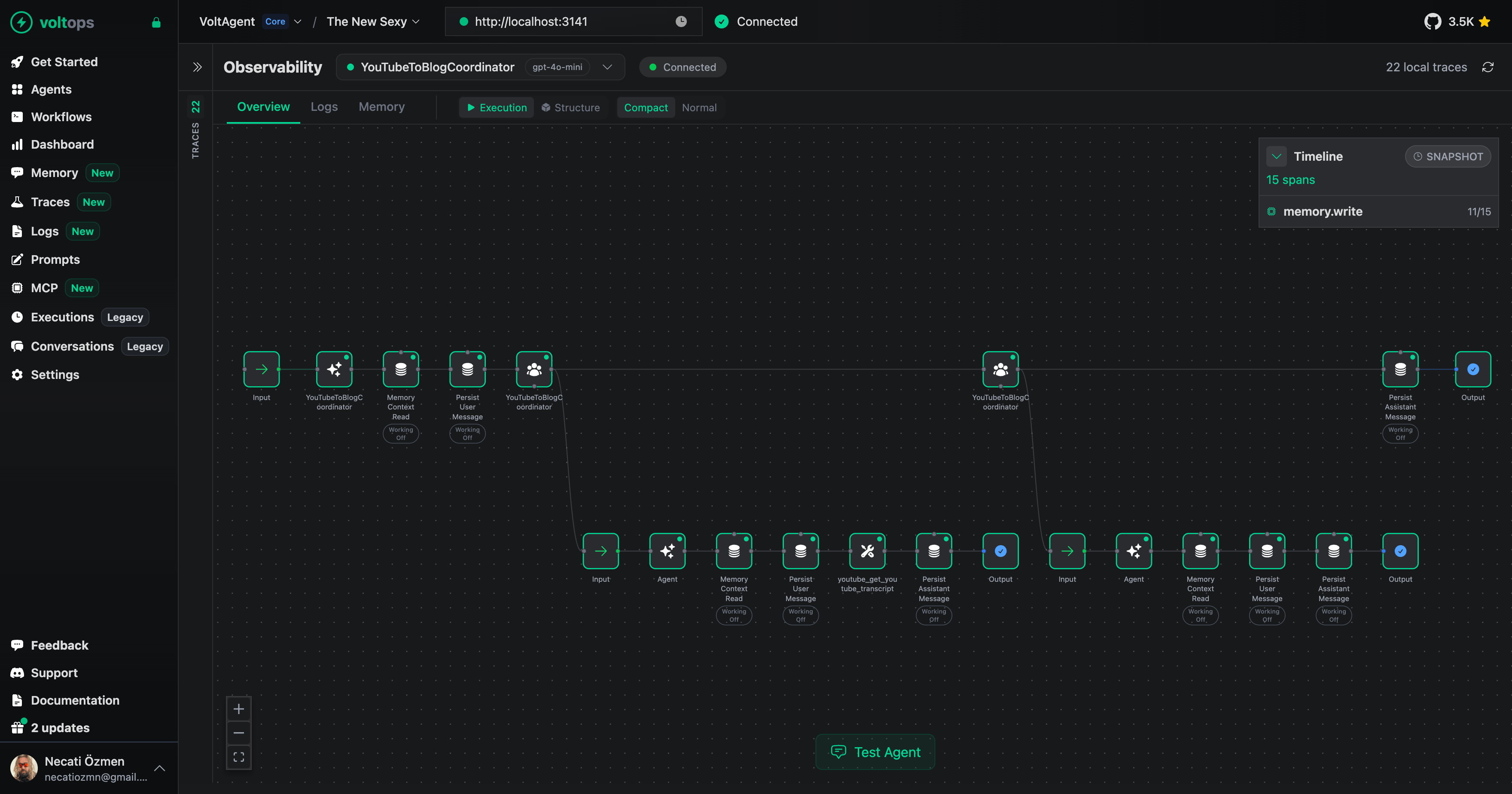
TranscriptFetcher Subagent
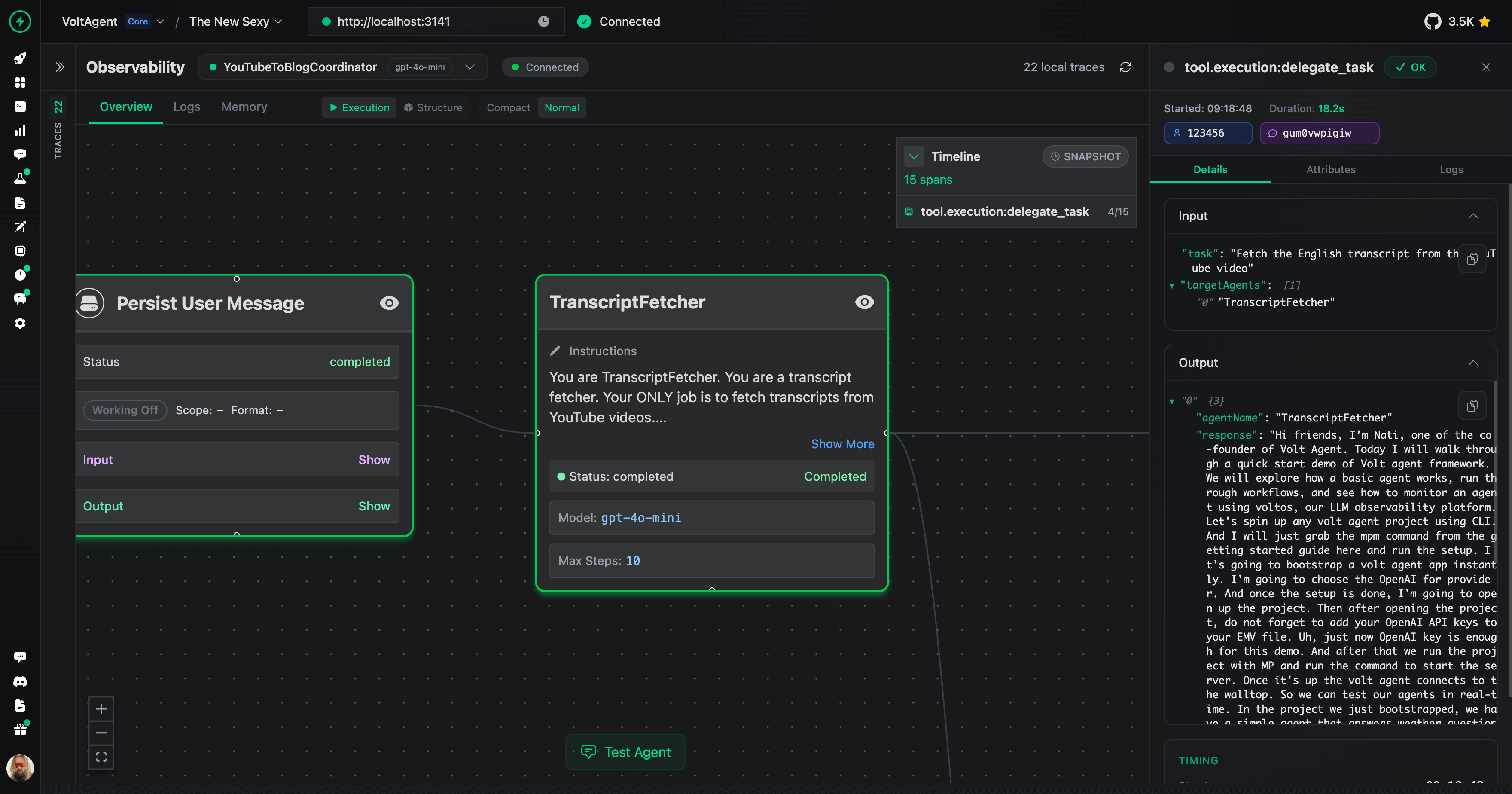
TranscriptFetcher handles pulling the raw transcript from the YouTube MCP tool.
const transcriptFetcherAgent = new Agent({
name: "TranscriptFetcher",
instructions: `
You are a transcript fetcher. Your ONLY job is to fetch transcripts from YouTube videos.
IMPORTANT:
- When given a YouTube URL, use your tools to extract the English transcript
- Return ONLY the raw transcript text
- DO NOT write blog posts
- DO NOT format the transcript into articles
- DO NOT add any additional content or commentary
- Just extract and return the transcript as-is`,
model: openai("gpt-4o-mini"),
tools: youtubeTools,
memory,
});
nameis how the supervisor or an API caller refers to this agent.instructionsforce the agent to send back raw transcript text and nothing else.modeluses@ai-sdk/openaiwithgpt-4o-mini, which keeps transcript calls fast and inexpensive.toolscontains the MCP transcript function discovered earlier.memoryconnects the agent to the shared working store so retries can reuse earlier context.
BlogWriter Subagent
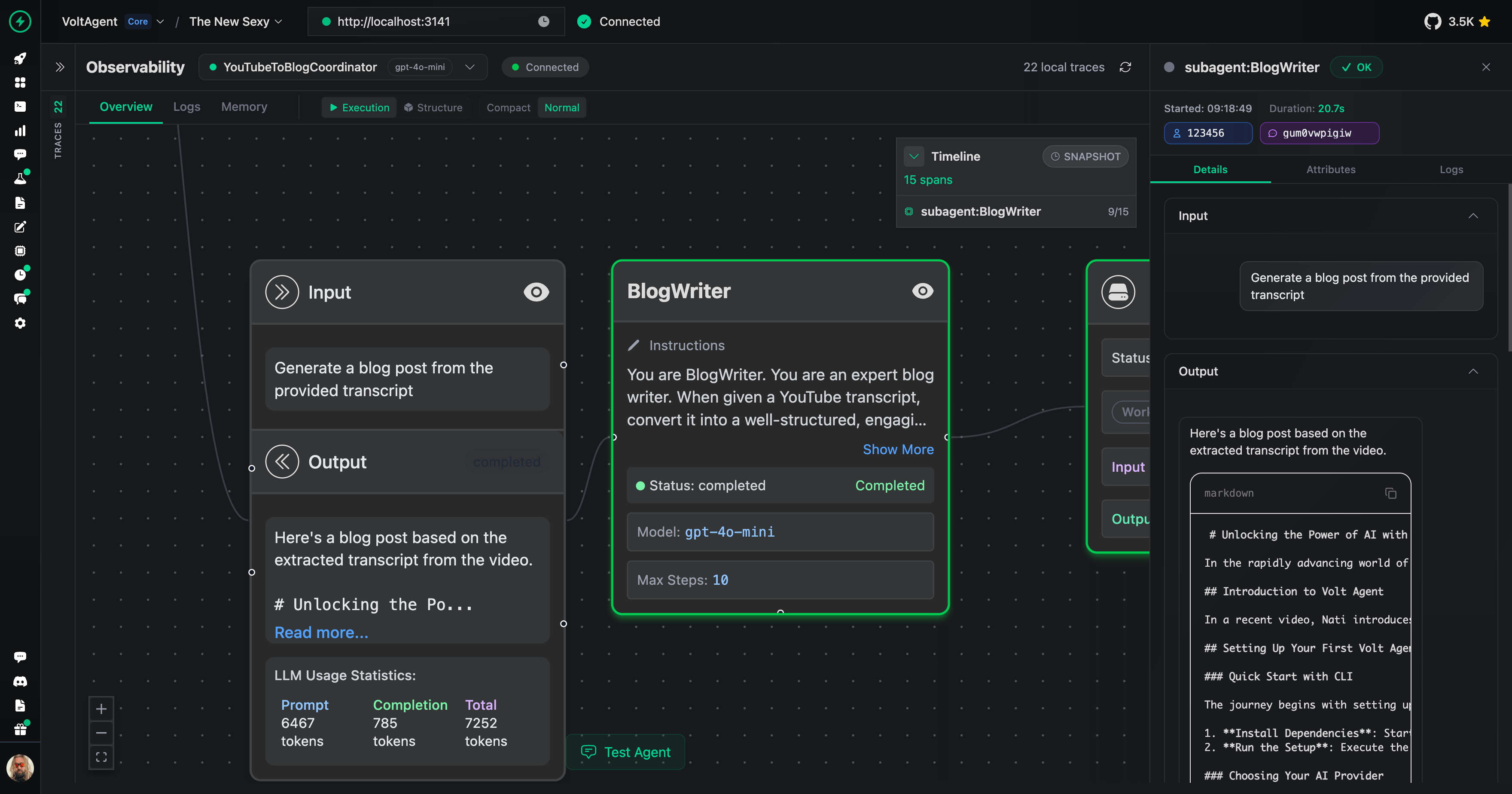
BlogWriter converts the transcript into a Markdown article with defined sections.
const blogWriterAgent = new Agent({
name: "BlogWriter",
instructions: `
You are an expert blog writer. When given a YouTube transcript, convert it into a well-structured, engaging blog post with:
- A catchy, SEO-friendly title
- An engaging introduction
- Clear sections with subheadings
- Key points and takeaways
- A compelling conclusion
Format the output in Markdown.`,
model: openai("gpt-4o-mini"),
memory,
});
- The instructions describe the Markdown layout I expect in the final response.
- The shared memory instance keeps the transcript available without fetching it again.
- Because VoltAgent wraps the provider logic, I can swap to another LLM that the AI SDK supports.
Coordinator Supervisor
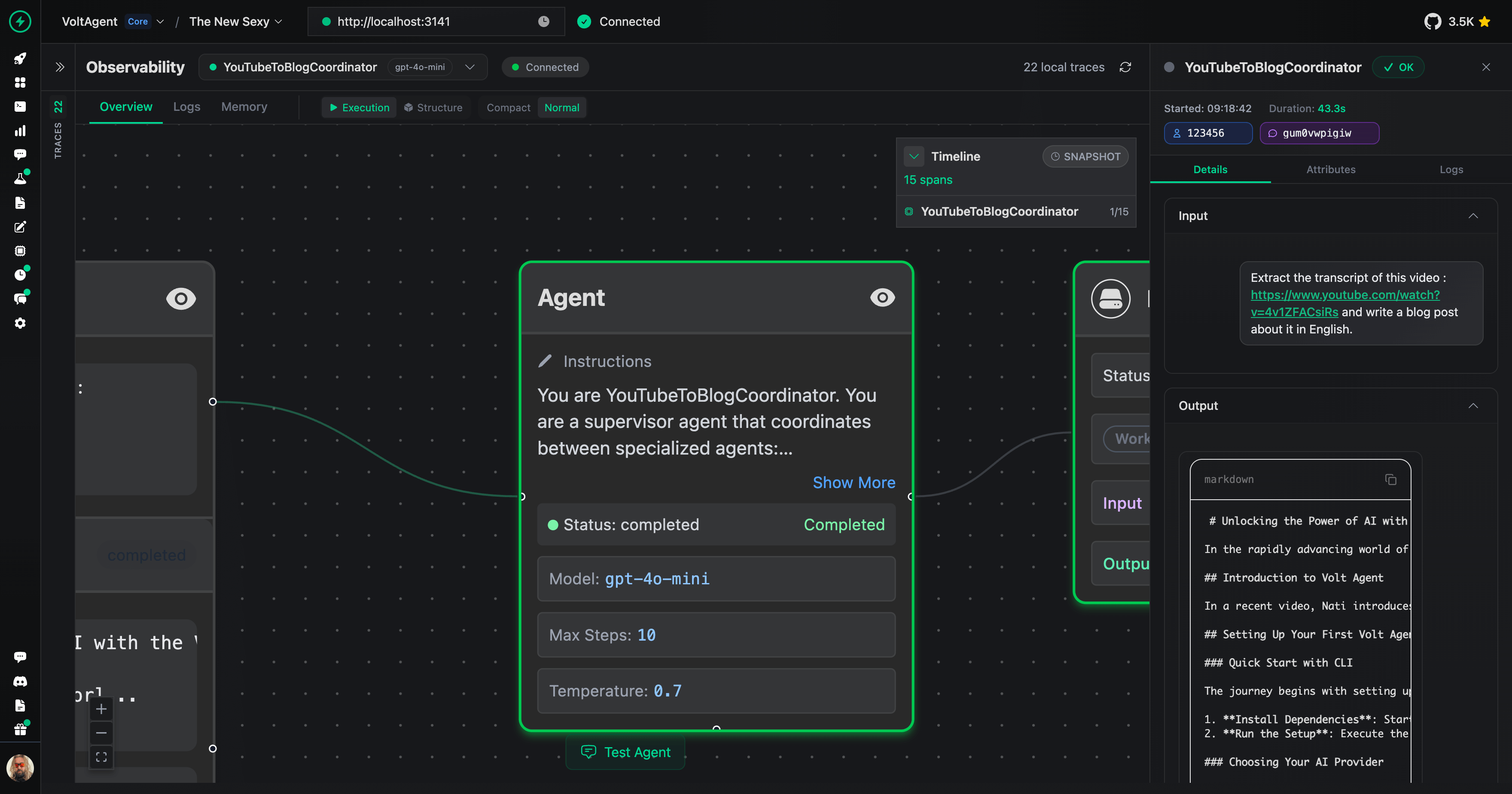
The supervisor enforces the handoff order and delegates work to both subagents.
const coordinatorAgent = new Agent({
name: "YouTubeToBlogCoordinator",
instructions: `
You are a coordinator that orchestrates the process of converting YouTube videos to blog posts. You DO NOT write the blog post yourself - that is the BlogWriter's job.
IMPORTANT: You MUST follow these steps in EXACT ORDER:
STEP 1: Get the Transcript
- Delegate to the TranscriptFetcher agent with the YouTube URL
- WAIT for the TranscriptFetcher to complete and return the full transcript
- DO NOT proceed to Step 2 until you have the complete transcript
STEP 2: Generate the Blog Post
- After you have the COMPLETE transcript, delegate to the BlogWriter agent
- Pass the ENTIRE transcript to the BlogWriter
- DO NOT write the blog post yourself - let the BlogWriter do it
- WAIT for the BlogWriter to return the complete blog post
STEP 3: Return ONLY the Blog Post
- Return ONLY the blog post content that the BlogWriter created
- DO NOT add any additional commentary, explanations, or meta-information
- Just return the blog post as-is
CRITICAL RULES:
- Complete Step 1 entirely before starting Step 2
- You are ONLY a coordinator - BlogWriter creates the blog post, NOT you
- Your final response should be ONLY the blog post content from BlogWriter`,
model: openai("gpt-4o-mini"),
memory,
subAgents: [transcriptFetcherAgent, blogWriterAgent],
supervisorConfig: {
fullStreamEventForwarding: {
types: ["tool-call", "tool-result"],
},
},
});
subAgentsregisters the transcript and writer agents, so the supervisor can call them with the built-indelegate_tasktool described in the subagent guide.supervisorConfig.fullStreamEventForwardingforwards tool events to the caller, which VoltOps stores for observability.- The shared memory instance lets the supervisor hand the transcript to the writer without restating it in the prompt.
Memory and Observability
I reuse LibSQL adapters for working memory and observability. See the memory overview and VoltOps guide for configuration details.
const memory = new Memory({
storage: new LibSQLMemoryAdapter(),
});
const observability = new VoltAgentObservability({
storage: new LibSQLObservabilityAdapter(),
});
LibSQLMemoryAdaptercaps each conversation at 100 messages and can target local SQLite or remote Turso instances.VoltAgentObservabilitycaptures spans, logs, and tool events that VoltOps renders in the web console.
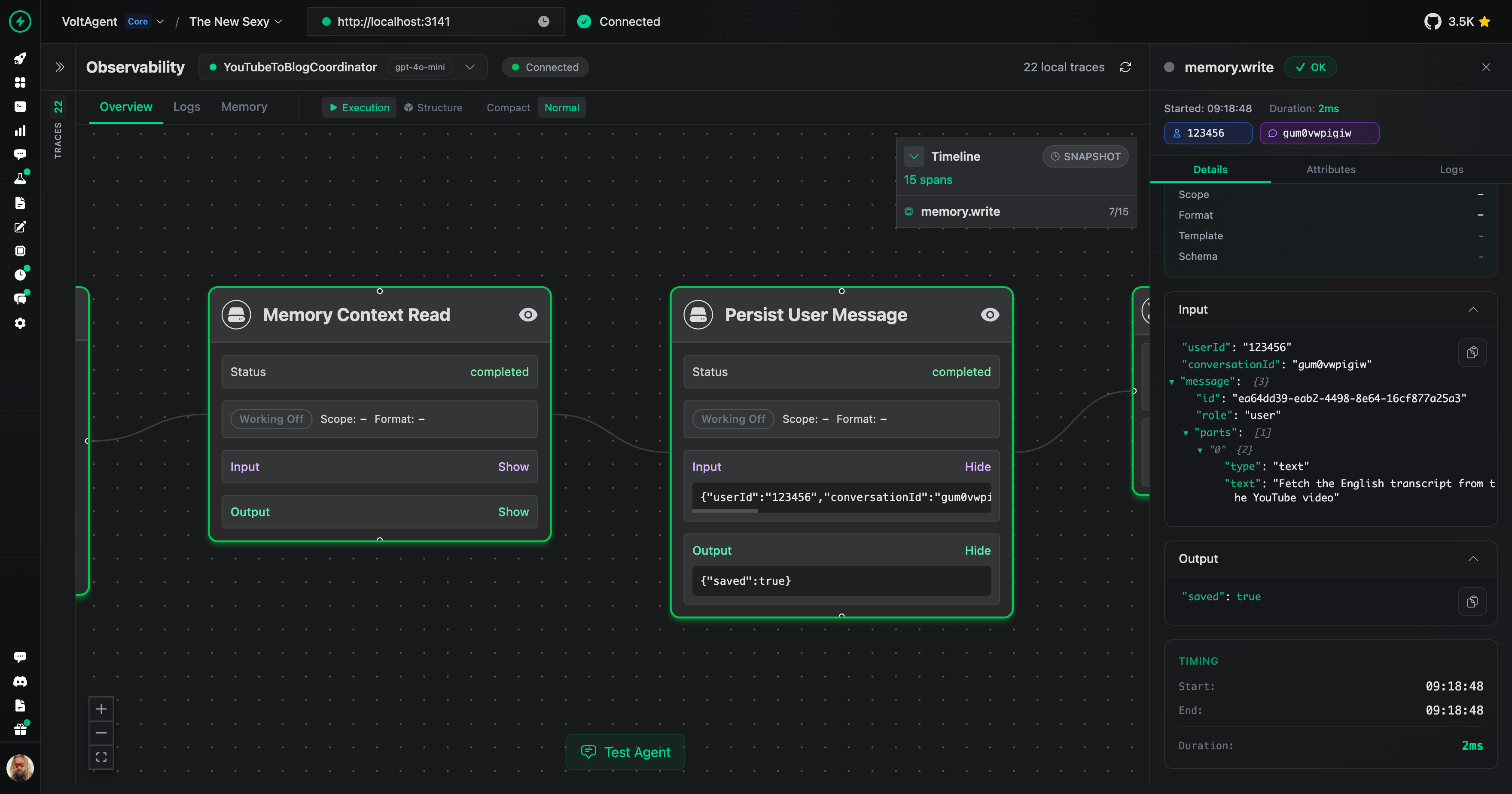
VoltAgent Server Configuration
new VoltAgent({
agents: {
coordinatorAgent,
transcriptFetcherAgent,
blogWriterAgent,
},
server: honoServer(),
logger,
observability,
});
- Registers all three agents so I can call them individually or through the supervisor.
- Exposes an HTTP interface using Hono at
http://localhost:3141. - Attaches the
observabilityinstance so trace data persists without extra wiring.
Running the Agent
Once deployed, the agent handles natural conversations for incoming requests.

I watch the coordinator delegate work in three steps:
TranscriptFetchercalls the MCP tool to retrieve the English transcript.BlogWriterreceives the transcript and formats a structured Markdown article.- The supervisor returns the Markdown output without extra commentary.
VoltOps captures each delegation, tool call, and LLM response, so I can inspect the chain step by step.
Prompt example:
Extract the transcript of this video: https://www.youtube.com/watch?v=U6s2pdxebSo and write a blog post in English.
Next Steps
Here are the next improvements on my list:
- Integrate additional MCP providers (for example, keyword research or SEO scoring) before handing the transcript to the writer.
- Add guardrail agents that fact-check statistics or detect sensitive topics before publication.
- Persist finished articles to a CMS via webhooks or a platform-specific API.
- Allow the coordinator to branch into multiple writing styles (technical deep dive, social recap, executive summary) based on user preferences.
- Introduce human-in-the-loop review stages using VoltAgent workflows and the VoltOps timeline UI.